Abstract
Researching the mechanical characteristics of concrete subjected to the freeze–thaw cycle is crucial for building engineering in cold climates. As a result, uniaxial compression tests were performed on concrete samples exposed to various freeze–thaw (F–T) cycles, and the measurements of the pore size distribution, porosity, and P-wave velocity of the saturated concrete samples were obtained, both before and after being exposed to the F–T cycles. Concrete’s F–T damage mechanism and damage evolution model were thoroughly examined. Using rock structure and moisture analysis test equipment to observe the T2 spectrum, the results showed that the F–T cycles can cause the internal structure of the samples to deteriorate. Porosity and F–T cycles have a positive correlation, although P-wave velocity has a negative correlation with the F–T cycles. As the F–T cycles increased, the specimens’ peak strength and elastic modulus steadily declined, while the peak strain clearly exhibited an increasing trend. A microscopic F–T damage model that takes into account the pore size distribution was developed, based on the relative changes in the pore structure distribution (PSD), before and after the F–T cycles. The concrete sample damage evolution law under various F–T cycles was examined using the following metrics: total energy, pore size distribution, static and dynamic elastic moduli, porosity, and P-wave velocity. Uniaxial compressive strength (UCS) and peak strain tests were used to evaluate the accuracy of the pore size distribution damage model, as well as that of five other widely used damage models.
1. Introduction
In civil engineering projects such as the construction of homes, highways, bridges, slopes, tunnels, foundations, hydraulic concrete structures, petroleum engineering edifices, nuclear waste disposal sites, and enhanced geothermal systems, concrete is one of the most popular and extensively utilized building materials [1,2,3]. For an extended period, concrete is subjected to alternating cycles of seasonal and diurnal temperatures, known as freezing and thawing (F–T) cycles. This damage and deterioration of concrete is a major cause of the instability and failure of concrete materials and structures, and it plays a crucial role in the study of the durability of concrete in cold climates [4,5,6,7]. Due to the severe deterioration of concrete materials, both domestically and internationally, brought on by the F–T cycle, increased requirements are also placed on the freeze resistant durability of concrete structures in the harsh natural environment of cold areas [8,9,10,11]. The north and northeast of China, North Dakota in the United States, and Canada are examples of cold places, both domestically and internationally, where winters are long, cold, and exhibit significant day-to-night temperature differences. The F–T cycles must be repeatedly endured by concrete materials each year. The internal concrete structure will eventually deteriorate with time, causing the building’s bearing capability to be lost. Building stability and safety are seriously threatened by the F–T cycle [12,13,14,15,16,17,18,19,20]. Thus, one of the key elements influencing the stability and longevity of engineering structures is the F–T resistance of the concrete material. Studying and precisely identifying the F–T damage process of concrete is crucial for cold climate resource utilization and structural engineering [21,22,23,24,25].
Figure 1 illustrates the typical instances of F–T damage to structural elements and concrete materials in engineering. In frigid climates, a large number of dams and other hydraulic structures have experienced significant F–T degradation prior to the completion of their planned service life [26,27,28,29]. The interior pore structure of the concrete must be saturated with water infiltration for F–T degradation to occur, and the concrete must exist in a temperature environment that is subjected to both positive and negative change [30,31]. Surface denudation and the internal loose cracking of concrete are caused by the free water of the solidified and hardened concrete being subjected to the alternating action of freezing (when the temperature is below the freezing point) and thawing (when the temperature is above the freezing point) when the temperature changes [32,33,34,35]. Concrete’s internal pore structure deteriorates due to the cold weather, causing the water within to remain in an alternating state of F–T cycles for extended periods of time. This ultimately results in irreversible F–T damage to the concrete’s mechanical and physical properties [36,37,38].
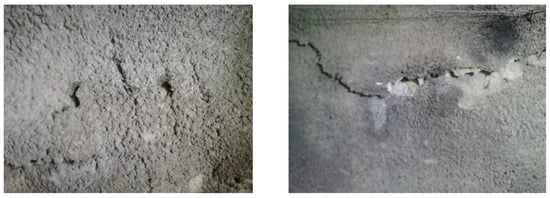
Figure 1.
Concrete material destroy caused by F–T cycle action.
The majority of researchers have conducted a significant number of theoretical investigations, as well as experimental work, to determine the impact of F–T cycles on the mechanical and physical characteristics of concrete materials [39,40,41,42]. The five-damage models listed below serve as a basic summary of the findings of this theoretical analysis. The damage models that are classified as (1) P-wave [43,44,45,46,47], (2) porosity [48,49,50,51,52,53,54], (3) static elastic modulus [55,56,57,58,59], (4) dynamic-elastic modulus [60,61,62,63], and (5) energy damage models [63,64,65,66,67,68,69]. Nearly all of the fundamental mechanical and physical characteristics form the basis of the current F–T damage models [70,71,72,73,74,75]. Nevertheless, there are few reports regarding the development of damage factor and damage models based on the distribution of microscopic pore sizes to quantitatively assess the degree of internal damage in concrete under F–T cycle circumstances [76,77,78]. Therefore, a damage model considering the microscopic pore size distribution was introduced to quantify the concrete sample damage evolution process during F–T cycles. In addition, the six-damage model is rarely considered to quantitatively compare and evaluate the degree of internal damage of concrete under F–T cycle conditions. Therefore, the damage variables were created to indicated the damage evolution process of concrete samples subjected to various F–T cycles based on wave velocity, static elastic modulus, porosity, dynamic-elastic modulus, energy, and pore size distribution.
In order to investigate how F–T cycles affect the macroscopic and microscopic mechanical characteristics of saturated concrete specimens under uniaxial compression conditions, a thorough analysis was conducted on the changes in the mechanical characteristics, porosity, P-velocity, and pore size distribution across the F–T cycles. To measure and assess the damage evolution process of concrete samples subjected to various F–T cycles, the damage factor and damage model were created based on wave velocity, static elastic modulus, porosity, dynamic-elastic modulus, energy, and pore size distribution. The ideal damage evolution prediction model was produced by comparing the predicted values with the experimental values. The six-damage model was introduced to forecast the UCS and peak strain of concrete samples during the F–T cycle process.
2. Damage Variables Reviews
2.1. Damage Factors Established Based on the P-Wave Velocity
With the development of nondestructive testing technology, the ultrasonic method has been widely used in many research fields due to its advantages, e.g., simple operation, low costs, and small influence on materials. The ultrasonic detection method is a convenient way to obtain the internal information regarding a substance through ultrasonic waves [79]. The wave velocity type usually adopted is the P-wave velocity, and the F–T damage variable of the concrete is defined as:
where and are the P-wave velocity before and after the F–T cycles experienced by the concrete.
2.2. Damage Factors Established Based on the Static Elastic Modulus
The degree of deterioration inside rock and concrete materials can be characterized by the macroscopic physical and mechanical properties of the materials based on the theory of damage mechanics. The change in the elastic modulus of rock and concrete materials exhibits a reliable consistency with its damage and deterioration processes. In addition, the elastic modulus of concrete and rock materials after experiencing the F–T cycle is easy to analyze and measure, and it can be utilized as a parameter to quantitatively assess the damage of concrete and rock materials. Therefore, the damage variable of concrete can be defined based on the change in the elastic modulus, before and after F–T cycles, as follows:
where E0 and En are the elastic modulus before and after the F–T cycle treatment.
2.3. Damage Factors Established Based on the Porosity
The change in porosity is the fundamental reason for the change in macroscopic mechanical properties of rock and concrete samples. Therefore, the porosity is used to define the damage variable to reflect the degree of damage in rocks under different F–T cycles. The microscopic F–T damage variable expression is as follows:
where is the microscopic F–T damage variable of the rock, is the porosity of the concrete sample subjected to n F–T cycles, and is the initial porosity of the concrete sample.
2.4. Damage Factors Established Based on the Dynamic Elastic Modulus
The longitudinal wave velocity defined by the elastic theory is as follows:
where is the P-wave velocity of the concrete, is the dynamic elastic modulus before the F–T cycles, and is Poisson’s ratio of the concrete; the damage variable is defined by the dynamic elastic modulus of the concrete as follows:
If the change of Poisson’s ratio in the F–T cycles is not considered, Equation (4) is substituted into Equation (5) to obtain the following equation:
where V is the unit mass volume of the concrete before F–T cycles; , , and are the density, unit mass volume, and P-wave velocity of the concrete after F–T cycles, respectively.
The volume of the concrete will be irreversibly expanded and deformed under the F–T cycle action. The change in the concrete volume is the result of the initiation and evolution of micropores and fissures. If the matrix deformation is not considered, the volume change in concrete, before and after the F–T cycles, can be expressed as follows:
where and are, respectively, the volume of the matrix and pore of the concrete before the F–T cycles; is the pore volume variation in the concrete, before and after the F–T cycles.
The porosity of the concrete before the F–T cycles can be expressed as follows:
The porosity of the concrete after the F–T cycles can be expressed as follows:
By substituting Equations (7)–(9) into Equation (6), we can get
Equation (10) is the concrete F–T damage variable expressed by the concrete porosity and the P-wave velocity [80].
2.5. Damage Factors Established Based on Energy
A damage model was established to calculate the F–T damage factors, according to the changes of input energy required by the samples before and after F–T treatment, as follows:
where U0 and Un are the total energy before and after the F–T cycles treatment. The energy calculation method is based on that found in Ref. [73].
2.6. Damage Factors Established Based on Microscopic Pore Size Distribution
Presently, numerous scholars have established many significant damage models for quasi-brittle materials such as the concrete based on basic physical and mechanical parameters. These models include evaluating the porosity, static elastic modulus, dynamic-elastic modulus, volume, P-wave, fractal dimension, energy, etc. [81,82]. Pore size distribution exerts significant effects on rock and concrete materials [83]. The different T2 spectral areas represent the different pore contents of corresponding sizes from the T2 spectrum, and the damage variables, considering the different pore sizes of the concrete exposed to F–T cycle treatment, are established as follows:
where Pmicro, Pmeso, Pmacro, P′micro, P′meso, and P′macro represent the spectral area of the micropores, the mesopores and the macropores in the T2 spectrum for the concrete, before and after exposure to the F–T cycles via the NMR testing; P′micro, P′meso, and P′macro represent the micropores, the mesopores, and the macropores after the F–T cycles. d, e, and f are the weights. the corresponding weight is calculated using Equation (14).
The coefficient of variation of the spectral peak area corresponding to the pores of each size inside the concrete samples subjected to different F–T cycles was obtained using the Equation (13), as follows:
where is the coefficient of variation; and are the standard deviation and average of the peak area index.
The coefficients of variation of the peak areas of the micropores, the mesopores, and the macropores were 0.213, 0.256, and 0.536, respectively. The corresponding weight is calculated using Equation (14). The weights d, e, and f of the micropores, the mesopores, and the macropores were 0.215, 0.292, and 0.503, respectively.
3. Experimental Scheme
3.1. Sample Preparation
The concrete samples were created by combining water, sand, and regular Portland cement. The sand was a mixture of 60% fine (0.1~0.25 mm) and 40% medium (0.25~0.40 mm) sands, the water is regular tap water, and the cement is 42.5 strength grade P.I. Portland cement [84]. To create the concrete samples, the cement, sand, and water were combined in a blender at a weight ratio of 2:1:0.4 [84]. Subsequently, the newly mixed concrete was transferred into a 50 mm diameter and 100 mm high cylindrical mold. Using a vibrating table, the mold containing the fresh concrete was vibrated for 10 min. It was then maintained at room temperature (20 °C) for 28 days. The concrete specimen test scheme under different conditions is shown as Table 1.

Table 1.
Concrete samples test scheme under different conditions.
3.2. Experimental Process and Equipment
The specific test process includes the P-wave velocities test, the drying test, the vacuum saturation test, the F–T cycles test, the PSD test, and the UCS test. The test procedure is illustrated in Figure 2. The specific steps are as follows:
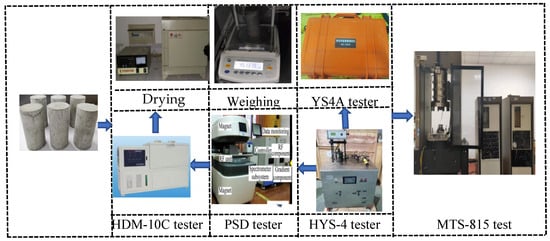
Figure 2.
Diagram of test equipment and procedures.
- (1)
- The six samples with similar P-wave velocities were selected via the P-wave velocities test at the YS4A tester.
- (2)
- The samples were dried at 105 °C for 24 h in the vacuum drying oven. The samples were vacuumed at 0.1 MPa pressure for 6 h in a vacuum saturated facility. Then, the internal pores were completely saturated with water at a pressure of 5 MPa for 24 h at the HYS-4 tester.
- (3)
- The pore structure distribution of saturated samples before the F–T cycles was measured using the rock structure and moisture analysis test equipment.
- (4)
- The samples were maintained at the HDM-10C tester for the F–T cycles test. One cycle of the F–T experimental process is shown in Figure 3. The F–T cycles consisted of 0, 10, 20, 30, 40 and 50, respectively [35]. Following the F–T cycles test, the above steps were repeated by monitoring the P-wave velocity and the PSD.
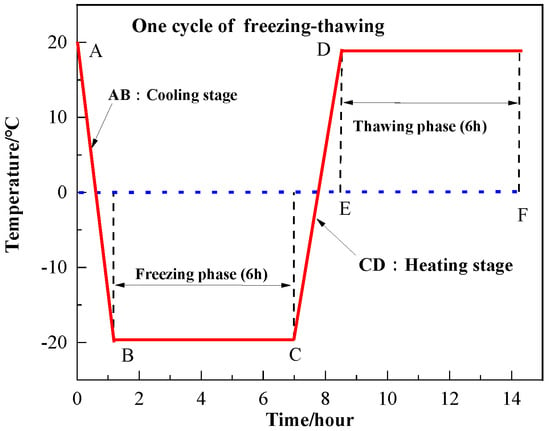 Figure 3. Experimental setup of F–T cycles.
Figure 3. Experimental setup of F–T cycles. - (5)
- Finally, the UCS tests were performed at a rate of 0.05 MPa/min using the MTS-815 loading tests system for the samples that had been exposed to different numbers of F–T cycles at room temperature (25 °C).
4. Experimental Results and Analysis
4.1. Pore Size Distribution
The change in the T2 spectrum can reflect the change in the pore structure in the rock. The rock structure and moisture analysis test equipmentdetects the relaxation response of the 1H proton via the CPMG pulse sequence test in the samples, and then the amplitude of the attenuation signal of the spin echo string is obtained. The set of all attenuation amplitude results forms the T2 spectrum [85]. Due to the porous media properties of the concrete, there is no unified criterion for the classification of pore size at present. As can be observed in Figure 4, the T2 distribution of the samples can be mainly divided into three peaks, corresponding to the transverse relaxation time T2 spectrum of the micropores (0.01~4 ms), mesopores (4~100 ms), and macropores (100~10,000 ms), as shown from left to right [86,87,88,89].
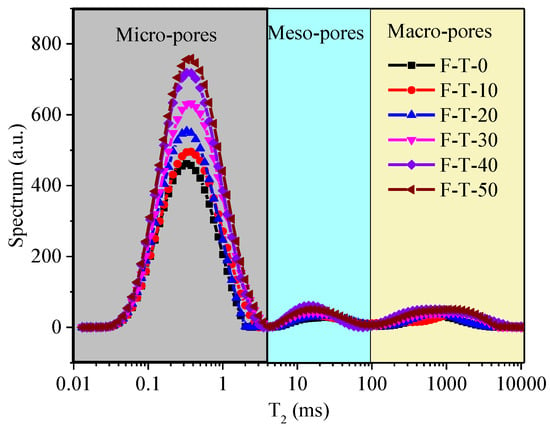
Figure 4.
T2 spectrum of concrete samples before and after F–T cycles.
4.2. The Variation in Porosity
The porosity of a saturated concrete samples is positively proportional to the NMR signal of its pore water pressure [90]. Hence, the porosity of the concrete samples can be obtained using Equation (15), as follows:
where and are the total porosity and the porosity of the class i dimension pores (%), respectively. P(0), P100%(0), and P0i represent the total signal intensity, the signal intensity produced, and the signal intensity of pores of the class i dimension, respectively.
The test results and the calculation of porosity are shown in Figure 5. With the increase in the number of F–T cycles, the change in the porosity of the samples was positively correlated with the F–T cycles. The porosity of the samples after 10 F–T cycles increased by 10.15% compared with that of the samples without exposure to the F–T cycles. The porosity of the samples after 20 F–T cycles increased by 12.01% compared with that after 10 F–T cycles; the porosity of the samples after 30 F–T cycles increased by 14.21% compared with that after 20 F–T cycles; and the porosity of the samples after 40 F–T cycles increased by 15.50% compared with that after 30 F–T cycles. The porosity of the samples after 50 F–T cycles increased by 16.08% compared with that after 40 F–T cycles. This indicates that the pore structure damage of the samples after numerous F–T cycles was significant more serious than that causes by the previous 10 F–T cycles. This is because the first 10 F–T cycles have little influence on the pore structure of the samples, but the F–T cycles caused a certain auxiliary effect on the development of the pore structure of the sample. With the increase in the number of F–T cycles, the number of newly generated pores continues to increase, gradually developing into mesopores and macropores, which develop continuously, expanding and connecting to form microcracks, causing a significant increasing in the porosity of the samples.
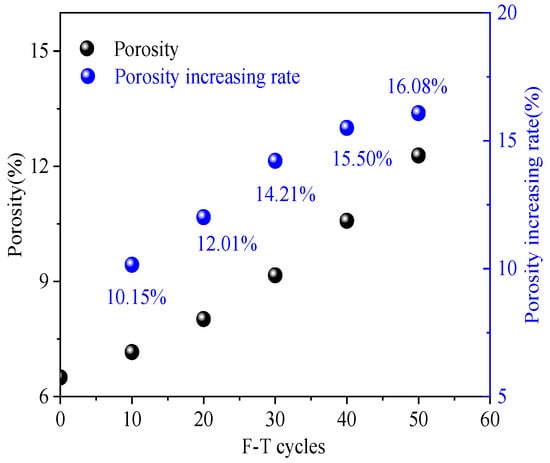
Figure 5.
The change in the porosity of concrete samples under F–T cycles.
4.3. The Variation in P-Velocity
The changes in P-wave velocity, before and after F–T cycles, are presented in the Figure 6. The P-wave velocity of the samples decreases as the F–T cycles increase. The internal pores of the sample developed after 10 F–T cycles, and the P-wave velocity decreased from 4.61 km/s to 4.44 km/s, a decrease of 3.68%. After 20 F–T cycles, the P-wave velocity of the samples decreased from 4.5 km/s to 4.15 km/s, a decrease of 7.77%. After 30 F–T cycles, the P-wave velocity decreased from 4.37 km/s to 3.81 km/s, a decrease of 12.81%. With the increase in the number of F–T cycles, the pores continued to develop and began to connect, and the total number increased significantly. After 40 F–T cycles, the P-wave velocity of the samples decreased from 4.29 km/s to 3.44 km/s, a decrease of 19.81%, After 50 F–T cycles, the wave velocity of the samples decreased from 4.2 km/s to 3.19 km/s, a decrease of 24.04%.
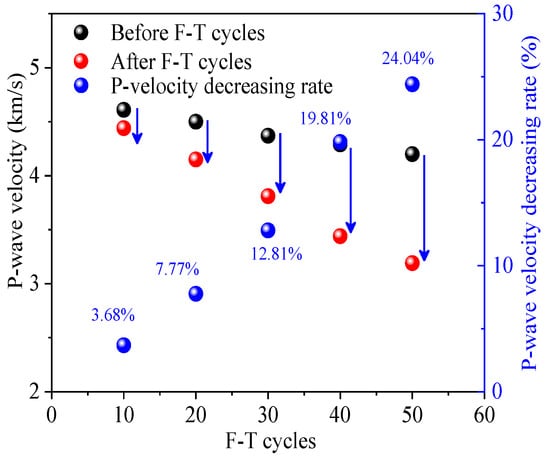
Figure 6.
P-velocity of concrete samples before and after F–T cycle treatment.
This is due to the fact that the F–T cycle effect creates a huge number of pores in the concrete samples, altering the internal structure and ultrasonic wave propagation mode and path. Constantly forming new pores, the existing pores also keep growing and spreading as the F–T cycle times rise. The sample’s mechanical strength and P-wave velocity significantly decrease as a result of the initial pores continuing to expand with each cycle due to the irreversible breakdown of the pore structure within the sample. The changes in both the porosity and the P-wave velocity were in good agreement, suggesting that material deterioration and damage buildup occur as the frequency of F–T cycles increases.
4.4. Changes in Mechanical Properties
Figure 7 depicts the alterations in the fundamental mechanical characteristics of concrete samples following various F–T cycles. Concrete samples that were not treated with F–T cycles exhibit clear signs of brittleness in their stress–strain curves. The stress–strain curves of the concrete samples exhibit a clear transition from brittleness to ductility as the number of F–T cycles increases. This is particularly evident for the treatment with 50 F–T cycles, which seems to indicate a yield platform. Furthermore, the samples’ compaction deformation stage lengthens as the number of F–T cycles increases during the initial loading stage. This is because there is a large number of F–T cycles creating new pores in the samples, and those pores must be compressed during the initial loading stage.
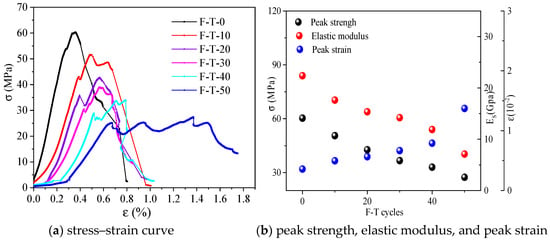
Figure 7.
Stress–strain, peak strength, elastic modulus, and peak strain for the concrete sample under F–T cycles.
A noticeable stress drop occurs in the elastic deformation stage as the number of F–T cycles increases, and as the number of F–T cycles increases, so does the stress needed to generate the stress reduction. This stems from the fact that the samples at this stage produce macrocracks, and the actions of the F–T cycles reduce the tension necessary for the production of macrocracks. As the number of F–T cycles increases, a clear yield plateau forms at the yield failure stage (pre-peak and post-peak stages). This phenomena is explained by the fact that the F–T cycles clearly damage the samples, causing them to transition from a brittle state to ductile failure. With the increase in the number of F–T cycles, the peak strength and elastic modulus of the samples decreased, while the peak strain increased. This is because the F–T cycles cause the original pores and cracks inside the samples to spread and generate new pore cracks, resulting in damage inside the samples, ultimately reducing the bearing capacity of the samples and their ability to resist deformation. The peak strain increased, but the peak strength and elastic modulus of the samples failed as the number of F–T cycles increased. This is due to the fact that the F–T cycles caused the pores and cracks inherent in the samples to propagate and create new pore cracks, causing internal damage that eventually reduced the bearing capacity and the resistance to deformation.
5. Discussion
5.1. Comparison of the Damage Variables under F–T Cycles
In order to further quantify the influence of the F–T cycles on the concrete samples, based on the above damage variable reviews, in this paper, the damage variables were compared and analyzed. The relationship between the F–T cycles and the porosity, total energy, static and dynamic elastic moduli, P-wave velocity, and pore size distribution is shown in Figure 8.
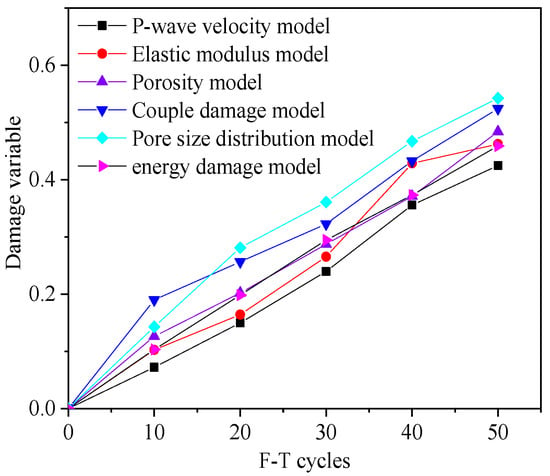
Figure 8.
The relationship between the damage factor and the F–T cycles.
The damage variable of the six-damage model shows a similar variation trend, as does the damage variable of the concrete samples, which increases as the number of F–T cycles increases. Furthermore, the PSD damage model demonstrated a greater sensitivity to the F–T cycles. Compared to the five-damage models, the PSD damage model performed better and showed smaller increases. For the six-damage models, the damage variables have an exponential connection with n, and the correlation coefficients are greater than 0.9159. The six-model damage evolution equations are as follows:
The damage variable of the concrete samples increases with the increase in the number of F–T cycles, and the damage variable of the six-damage models show a similar variation trend. In addition, the PSD damage model was more sensitive to the F–T cycles. The PSD damage model exhibits smaller increases than does the five-damage model. The damage variables were exponentially correlated with n for the six-damage model, and the correlation coefficients are greater than 0.9159. The damage evolution equation of the six models are as follows:
5.2. Comparison of the Damage Model under the F–T Cycles
By using parameter analysis and data fitting, some prediction models have been presented to investigated the law of concrete and rock strength loss under F–T cycles by means of parameter analysis and data fitting. M. Mutluturk et al. [91] first proposed a first-order model for predicting the integrity of rock F–T damage, and it has been widely applied. The integrity index of rock mass after the F–T cycles can be expressed as:
where and are the integrity indexes of rocks before and after the F–T cycles; is the decay constant that can be calculated from the half-decay period of the rock.
It can be seen that the UCS of rock after experiencing F–T cycles is related to the initial strength of rock and the degree of F–T cycle damage. The nonlinear prediction equation of the UCS of concrete was proposed, based on Equation (16), as follows [91]:
where and are the UCS of the concrete samples before and after the F–T cycles. The damage variable can be expressed as follows:
Figure 9 displays the experimental and predicted UCS values of the concrete samples subjected to various F–T cycles. As the number of the F–T cycles increased, the predicted values of the wave velocity model, the static and dynamic elastic modulus model, the porosity model, and the energy model were all greater than the experimental values. The largest discrepancies between the predicted and the experimental values after 30 cycles were 25.6%, 20.82%, 17.24%, 11.43%, and 16.03%. The experimental values of concrete prior to 40 F–T cycles were most closely aligned with the anticipated values of the pore size distribution damage model; the errors were 2.24%, 1.57%, 5.14%, and 2.70%, respectively. the pore size distribution model’s projected value and the experimental value showed the least amount of error after 50 cycles, and the error was 0.73%. Therefore, the pore size distribution damage model can accurately predict the mechanical strength of concrete samples after F–T cycles.

Figure 9.
Comparison of predicted and experimental values of UCS for the concrete sample subjected to different F–T cycles.
Based on the change curve of the peak strain versus the number of F–T cycles, Gao et al. [66] defined the relative strain variables as follows:
Figure 10 show that the values of the peak strains predicted based on the pore size distribution damage model exhibit minimal errors and were stable when compared with the test results.
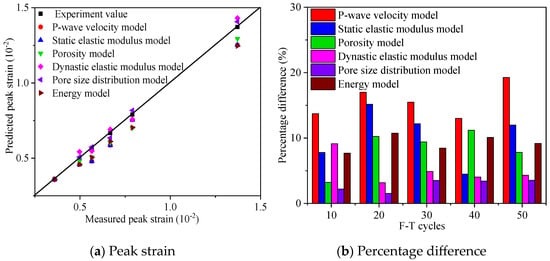
Figure 10.
Comparison of predicted and experimental values of peak strain for the concrete samples subjected to different F–T cycles.
6. Conclusions
In this study, we adopted to the ultrasonic tester and nuclear magnetic resonance (NMR) to investigating the effects of F–T cycles on the microscopic and macroscopic mechanical properties of saturated concrete specimens under uniaxial compression conditions. The main research results are summarized as follows:
The F–T cycles can lead to the deterioration of the internal structure of the samples based on the observation of the T2 spectrum using the rock structure and moisture analysis test equipment.
P-wave velocity is negatively correlated with the F–T cycles, while the porosity is positive correlated with the F–T cycles. The peak strength and elastic modulus of the specimens decrease gradually as the F–T cycles increase, and the peak strain shows an obvious increasing trend.
A microscopic F–T damage model, considering the pore size distribution, was established. The damage evolution law of concrete samples under different F–T cycles was analyzed based on the P-wave velocity, porosity, static elastic modulus, dynamic elastic modulus, total energy, and pore size distribution. The accuracy of the pore size distribution damage model and five other common damage models was tested using the uniaxial compressive strength (UCS) and the peak strain.
The newly proposed damage factor and damage model, considering the definition of pore structure changes before and after the freeze and thaw cycle, can effectively evaluate the freeze–thaw cycle properties of related concrete materials in cold areas. Without mechanical tests, it can evaluate the evolution process of the freeze–thaw damage of concrete materials, providing a reference for related projects.
Author Contributions
N.Z.: writing—original draft, writing—review and editing, investigation, and methodology; S.L.: conceptualization, validation, data curation, software, and formal analysis. All authors have read and agreed to the published version of the manuscript.
Funding
This research was funded by [National Natural Science Foundation of China] grant number [Grant No. 52274118 and No. 52274194].
Institutional Review Board Statement
Not applicable.
Informed Consent Statement
Not applicable.
Data Availability Statement
Data will be made available from the corresponding author (sllianzbsb@126.com) upon reasonable request.
Conflicts of Interest
The authors declare that they have no conflicts of interest regarding this work.
References
- Mouzannar, H.; Bost, M.; Leroux, M.; Virely, D. Experimental Study of the shear strength of bonded concrete-rock interfaces: Surface morphology and scale effect. Rock Mech. Rock Eng. 2017, 50, 2601–2625. [Google Scholar] [CrossRef]
- Xiang, W.; Liu, X. Experimental study of mechanical properties of combined specimen with rock and shotcrete under freezing-thawing cycles. Chin. J. Rock Mech. Eng. 2010, 29, 2510–2521. [Google Scholar]
- Suzuki, T.; Ogata, H.; Takada, R.; Aoki, M.; Ohtsu, M. Use of acoustic emission and X-ray computed tomography for damage evaluation of freeze-thawed concrete. Constr. Build. Mater. 2010, 24, 2347–2352. [Google Scholar] [CrossRef]
- Shi, X.; Fay, L.; Peterson, M.M.; Yang, Z. Freeze-thaw damage and chemical change of a Portland cement concrete in the presence of diluted deicers. Mater. Struct. 2010, 43, 933–946. [Google Scholar] [CrossRef]
- Wang, Z.; Zeng, Q.; Wang, L.; Yao, Y.; Li, K. Characterizing blended cement pastes under cyclic freeze-thaw actions by electrical resistivity. Constr. Build. Mater. 2013, 44, 477–486. [Google Scholar] [CrossRef]
- Suzuki, T.; Forde, M.; Ohtsu, M. Detection of local cracking damage of in-service concrete by AE and X-ray CT. In Proceedings of the 16th International Conference Structural Faults & Repair, Edinburgh, UK, 17–19 May 2016. [Google Scholar]
- Ohtsu, M. Nondestructive evaluation of damaged concrete due to freezing and thawing by elastic-wave method. J. Adv. Concr. Technol. 2005, 3, 333–341. [Google Scholar] [CrossRef][Green Version]
- Krounis, A.; Johansson, F.; Larsson, S. Effects of spatial variation in cohesion over the concrete-rock interface on dam sliding stability. J. Rock Mech. Geotech. Eng. 2015, 7, 659–667. [Google Scholar] [CrossRef]
- Shen, Y.; Wang, Y.; Yang, Q.; Sun, T.; Luo, H. Inflfluence of surface roughness and hydrophilicity on bonding strength of concrete-rock interface. Constr. Build. Mater. 2019, 213, 156–166. [Google Scholar] [CrossRef]
- Wang, X.; Wu, Y.; Shen, X.; Wang, H.; Liu, S.; Yan, C. An experimental study of a freeze-thaw damage model of natural pumice concrete. Powder Technol. 2018, 339, 651–658. [Google Scholar] [CrossRef]
- Zhou, J.; Ye, G.; van Breugel, K. Cement hydration and microstructure in concrete repairs with cementitious repair materials. Constr. Build. Mater. 2016, 112, 765–772. [Google Scholar] [CrossRef]
- Zhao, Y.L.; Wang, Y.X.; Wang, W.J.; Wan, W.; Tang, J.Z. Modeling of non-linear rheological behavior of hard rock using triaxial rheological experiment. Int. J. Rock Mech. Min. Sci. 2017, 93, 66–75. [Google Scholar] [CrossRef]
- Zhao, Y.L.; Zhang, C.S.; Wang, Y.X.; Lin, H. Shear-related roughness classification and strength model of natural rock joint based on fuzzy comprehensive evaluation. Int. J. Rock Mech. Min. Sci. 2017, 137, 104550. [Google Scholar] [CrossRef]
- Wang, Y.; Cao, Y. Water absorption and chloride diffusivity of concrete under the coupling effect of uniaxial compressive load and freeze–thaw cycles. Constr. Build. Mater. 2019, 209, 566–576. [Google Scholar] [CrossRef]
- Rong, X.L.; Zheng, S.S.; Zhang, Y.X. Experimental study on the seismic behavior of RC shear walls after freeze-thaw damage. Eng. Struc. 2020, 206, 110101. [Google Scholar] [CrossRef]
- Lian, S.L.; Wan, W.; Zhao, Y.L.; Peng, W.Q.; Du, C.; Hu, H. Study on the damage mechanism and evolution model of preloaded sandstone subjected to freezing–thawing action based on the NMR technology. Rev. Adv. Mater. Sci. 2024, 63, 20240034. [Google Scholar] [CrossRef]
- Yazdani, F. Damage Assessment, Characterization, and Modeling for Enhanced Design of Concrete Bridge Decks in Cold Regions; North Dakota State University: Fargo, ND, USA, 2015. [Google Scholar]
- Ronning, T.F. Freeze-Thaw Resistance of Concrete: Effect of Curing Conditions, Moisture Exchange and Materials; Norwegian Institute of Technology: Trondheim, Norway, 2001. [Google Scholar]
- Powers, T.C. A working hypothesis for further studies of frost resistance. J. ACI 1945, 16, 245–272. [Google Scholar]
- Powers, T.C.; Helmuth, R.A. Theory of volume change in hardened portl and cement paste during freezing. Highw. Res. Board. 1953, 32, 285–297. [Google Scholar]
- Shang, H.S.; Song, Y.P. Experimental study of strength and deformation of plain concrete under biaxial compression after freezing and thawing cycles. Cement. Concr. Res. 2006, 36, 1857–1864. [Google Scholar] [CrossRef]
- Zhao, Y.L.; Zhang, L.Y.; Wang, W.J.; Tang, J.Z.; Lin, L.; Wan, W. Transient pulse test and morphological analysis of single rock fractures. Int. J. Rock Mech. Min. Sci. 2017, 91, 139–154. [Google Scholar] [CrossRef]
- Wang, W.; Yang, X.; Huang, S.; Yin, D.; Liu, G. Experimental study on the shear behavior of the bonding interface between sandstone and cement mortar under freeze-thaw. Rock Mech. Rock Eng. 2020, 53, 881–907. [Google Scholar] [CrossRef]
- Li, T.Y.; Zhao, Y.L.; Liao, J. Experimental study on the seepage characteristics of dolomite fracture specimens before and after grouting. Arch. Appl. Mech. 2024, 94, 1723–1738. [Google Scholar] [CrossRef]
- Zhang, Y.J.; Zhao, Y.L.; Liu, Q.; Li, Y.; Lin, H. Energy evolution law of sandstone material during post-peak cyclic loading and unloading under hydraulic coupling. Sustainability 2024, 16, 24. [Google Scholar] [CrossRef]
- Mainali, G.; Dineva, S.; Nordlund, E. Experimental study on debonding of shotcrete with acoustic emission during freezing and thawing cycle. Cold Reg. Sci. Technol. 2015, 111, 1–12. [Google Scholar] [CrossRef]
- Dong, W.; Wu, Z.; Zhou, X.; Wang, N.; Kastiukas, G. An experimental study on crack propagation at rock-concrete interface using digital image correlation technique. Eng. Fract. Mech. 2017, 171, 50–63. [Google Scholar] [CrossRef]
- Soulioti, A.D.; Barkoula, N.M.; Paipetis, A.; Matikas, T.E.; Shiotani, T.; Aggelis, D.G. Acoustic emission behavior of steel fibre reinforced concrete under bending. Constr. Build. Mater. 2009, 23, 3532–3536. [Google Scholar] [CrossRef]
- Krounis, A.; Johansson, F.; Larsson, S. Shear strength of partially bonded concrete-rock interfaces for application in dam stability analyses. Rock Mech. Rock Eng. 2016, 49, 2711–2722. [Google Scholar] [CrossRef]
- Zhang, J.; Bian, F.; Zhang, Y.; Fang, Z.; Fu, C.; Guo, J. Effect of pore structures on gas permeability and chloride diffusivity of concrete. Constr. Build. Mater. 2018, 163, 402–413. [Google Scholar] [CrossRef]
- Huang, S.B.; Liu, Y.Z.; Guo, Y.L.; Zhang, Z.; Cai, Y. Strength and failure characteristics of rock-like material containing single crack under freeze-thaw and uniaxial compression. Cold Reg. Sci. Technol. 2019, 162, 1–10. [Google Scholar] [CrossRef]
- Wu, Q.; Chen, L.; Shen, B.T.; Bongani, D.; Li, S.Q.; Zhu, Y.J. Experimental investigation on rockbolt performance under the tension load. Rock Mech. Rock Eng. 2019, 52, 4605–4618. [Google Scholar] [CrossRef]
- Zhao, Y.L.; Liu, Q.; Zhang, C.S.; Liao, J.; Lin, H.; Wang, Y.X. Coupled seepage-damage effect in fractured rock masses: Model development and a case study. Int. J. Rock Mech. Min. Sci. 2021, 144, 103750. [Google Scholar] [CrossRef]
- Wang, Y.; Yuan, Q.; Deng, D.; Ye, T.; Fang, L. Measuring the pore structure of cement asphalt mortar by nuclear magnetic resonance. Constr. Build. Mater. 2017, 137, 450–458. [Google Scholar] [CrossRef]
- Shen, Y.; Yang, H.; Xi, J.; Yang, Y.; Wang, Y.; Wei, X. A novel shearing fracture morphology method to assess the influence of freeze-thaw actions on concrete-granite interface. Cold Reg. Sci. Technol. 2020, 169, 102900. [Google Scholar] [CrossRef]
- Wang, M.; Wan, W. A new empirical formula for evaluating uniaxial compressive strength using the Schmidt hammer test. Int. J. Rock Mech. Min. Sci. 2021, 123, 104094. [Google Scholar] [CrossRef]
- Lian, S.L.; Li, J.S.; Gan, F.; Bi, J.; Wang, C.L.; Zheng, K. Investigation of the shear mechanical behavior of sandstone with unloading normal stress after freezing-thawing cycles. Machines 2021, 9, 339. [Google Scholar] [CrossRef]
- Malik, S.K.; Bhattacharyya, S.V. Thermal and mechanical properties of concrete and its constituents at elevated temperatures: A review. Constr. Build Mater. 2021, 270, 121398. [Google Scholar] [CrossRef]
- Zhang, X.; Wang, L.; Zhang, J. Mechanical behavior and chloride penetration of high strength concrete under freeze-thaw attack. Cold Reg. Sci. Technol. 2017, 142, 17–24. [Google Scholar] [CrossRef]
- Zhou, X.P.; Niu, Y.; Zhang, Z.J.; Shen, X.C.; Zheng, Y.; Berto, F. Experimental study on effects of freeze-thaw fatigue damage on the cracking behaviors of sandstone containing two unparallel fissures. Fatigue Fract. Eng. Mater. Struct. 2019, 42, 1322–1340. [Google Scholar] [CrossRef]
- Lian, S.L.; Zheng, K.; Zhao, Y.; Bi, J.; Wang, C.L.; Huang, Y.S. Investigation the effect of freeze–thaw cycle on fracture mode classification in concrete based on acoustic emission parameter analysis. Constr. Build. Mater. 2023, 362, 129789. [Google Scholar] [CrossRef]
- Remy, J.M.; Bellanger, M.; Homand-Etienne, F. Laboratory velocities and attenuation of P-waves in limestones during freeze-thaw cycles. J. Geophys. 1994, 59, 245–251. [Google Scholar] [CrossRef]
- Takarli, M.; Pince, W.; Siddique, R. Damage in granite under heating/cooling cycles and water freeze-thaw condition. Int. J. Rock Mech. Min. Sci. 2008, 45, 1164–1175. [Google Scholar] [CrossRef]
- Inserra, C.; Biwa, S.; Chen, Y. Influence of thermal damage on linear and nonlinear acoustic properties of granite. Int. J. Rock Mech. Min. Sci. 2013, 62, 96–104. [Google Scholar] [CrossRef]
- Pan, W.H.; Sun, X.D.; Wu, L.M.; Yang, K.K.; Tang, N. Damage detection of asphalt concrete using piezo-ultrasonic wave technology. J. Mater. 2019, 12, 443. [Google Scholar] [CrossRef]
- Çelik, M.Y. Water absorption and P-wave velocity changes during freeze-thaw weathering process of crosscut travertine rocks. Environ. Earth. Sci. 2017, 76, 409. [Google Scholar] [CrossRef]
- Yu, J.; Chen, X.; Li, H.; Zhou, J.W.; Cai, Y.Y. Effect of freeze-thaw cycles on mechanical properties and permeability of red sandstone under triaxial compression. J. Mt. Sci. 2015, 12, 218–231. [Google Scholar] [CrossRef]
- Jia, H.L.; Xiang, W.; Krautblatter, M. Quantifying rock fatigue and decreasing compressive and tensile strength after repeated freeze-thaw cycles. J. Permafr. Periglac. Process. 2015, 26, 368–377. [Google Scholar] [CrossRef]
- Zhao, Y.L.; Liu, J.H.; Zhang, C.S.; Zhang, H.Q.; Liao, J.; Zhu, S.T.; Zhang, L.Y. Mechanical behavior of sandstone during post-peak cyclic loading and unloading under hydromechanical coupling. Int. J. Min. Sci. Technol. 2023, 33, 927–947. [Google Scholar] [CrossRef]
- Zhao, Y.L.; Wang, Y.X.; Wang, W.J.; Tang, L.M.; Liu, Q. MModeling of rheological fracture behavior of rock cracks subjected to hydraulic pressure and far field stresses. Theor. Appl. Fract. Mec. 2019, 101, 59–66. [Google Scholar] [CrossRef]
- Li, X.P.; Qu, D.X.; Luo, Y.; Ma, R.Q.; Xu, K.; Wang, G. Damage evolution model of sandstone under coupled chemical solution and freeze-thaw process. Cold Reg. Sci. Technol. 2019, 162, 88–95. [Google Scholar] [CrossRef]
- Liu, Q.; Xu, G.; Liu, X. Experimental and theoretical study on freeze-thawing damage propagation of saturated rocks. Int. J. Mod. Phys. B 2008, 22, 1853–1858. [Google Scholar] [CrossRef]
- Kang, Y.; Liu, Q.; Huang, S. A fully coupled thermo-hydro-mechanical model for rock mass under freezing/thawing condition. Cold Reg. Sci. Technol. 2013, 95, 19–26. [Google Scholar] [CrossRef]
- Huang, S.; Liu, Q.; Cheng, A.; Liu, Y. A statistical damage constitutive model under freeze-thaw and loading for rock and its engineering application. Cold Reg. Sci. Technol. 2018, 145, 142–150. [Google Scholar] [CrossRef]
- Tan, X.; Chen, W.; Yang, J.; Cao, J.J. Laboratory investigations on the mechanical properties degradation of granite under freeze-thaw cycles. Cold Reg. Sci. Tech. 2011, 68, 130–138. [Google Scholar] [CrossRef]
- Wang, C.; Zhan, S.F.; Xie, M.Z.; Wang, C.; Cheng, L.P.; Xiong, Z.Q. Damage characteristics and constitutive model of deep rock under frequent impact disturbances in the process of unloading high static stress. J. Complex. 2020, 1–15. [Google Scholar] [CrossRef]
- Wu, Q.H.; Yang, Y.; Zhang, K.X.; Li, Q.Y.; Chen, W.; Liu, Z.F. Study on the mechanical properties and deterioration mechanism of sandstones under different humidity conditions. J. Cent. South. Univ. 2023, 30, 4252–4267. [Google Scholar] [CrossRef]
- Zhang, H.M.; Meng, X.Z.; Yang, G.S. A study on mechanical properties and damage model of rock subjected to freeze-thaw cycles and confining pressure. Cold Reg. Sci. Technol. 2020, 174, 103056. [Google Scholar] [CrossRef]
- Lu, Y.N.; Li, X.P.; Han, Y.H.; Wu, J. Mechanical properties of rock specimens with a single natural weak plane after freeze-thaw action. Cold Reg. Sci. Technol. 2021, 181, 103179. [Google Scholar] [CrossRef]
- Petersen, L.; Lohaus, L.; Polak, M.A. Influence of freezing-thawing damage on behavior of reinforced concrete elements. JACI Mater. J. 2007, 104, 369–378. [Google Scholar]
- Hassanzadegan, A.; Blöcher, G.; Milsch, H. The effects of temperature and pressure on the porosity evolution of flechtinger sand-stone. Rock Mech. Rock Eng. 2014, 47, 421–434. [Google Scholar] [CrossRef]
- Dong, W.; Shen, X.D.; Xue, H.J.; He, J.; Liu, Y. Research on the freeze-thaw cyclic test and damage model of Aeolian sand lightweight aggregate concrete. Constr. Build. Mater. 2016, 123, 792–799. [Google Scholar] [CrossRef]
- Khazaei, C.; Hazzard, J.; Chalaturnyk, R. Damage quantification of intact rocks using acoustic emission energies recorded during uniaxial compression test and discrete element modeling. J. Comput. Geotech. 2015, 67, 94–102. [Google Scholar] [CrossRef]
- Chen, W.; Konietzky, H.; Tan, X.; Frühwirt, T. Pre-failure damage analysis for brittle rocks under triaxial compression. J. Comput. Geotech. 2016, 74, 45–55. [Google Scholar] [CrossRef]
- Deng, H.W.; Yu, S.; Deng, J.; Ke, B.; Bin, F. Experimental investigation on energy mechanism of freezing-thawing treated sandstone under uniaxial static compression. KSCE J. Civ. Eng. 2019, 23, 2074–2082. [Google Scholar] [CrossRef]
- Gao, F.; Cao, S.; Zhou, K.; Lin, Y.; Zhu, L. Damage characteristics and energy-dissipation mechanism of frozen-thawed sandstone subjected to loading. Cold. Reg. Sci. Tech. 2020, 169, 102920. [Google Scholar] [CrossRef]
- Wang, P.; Xu, J.Y.; Fang, X.Y.; Wang, P.X. Energy dissipation and damage evolution analyses for the dynamic compression failure process of red-sandstone after freeze-thaw cycles. Eng. Geol. 2017, 221, 104–113. [Google Scholar] [CrossRef]
- Wang, Y.; Gao, S.H.; Li, C.H.; Han, J.Q. Energy dissipation and damage evolution for dynamic fracture of marble subjected to freeze-thaw and multiple level compressive fatigue loading. Int. J. Fatigue 2021, 142, 105927. [Google Scholar] [CrossRef]
- Ma, Q.H.; Ma, D.D.; Yao, Z.M. Influence of freeze-thaw cycles on dynamic compressive strength and energy distribution of soft rock specimen. Cold Reg. Sci. Technol. 2018, 153, 10–17. [Google Scholar] [CrossRef]
- Li, J.L.; Kaunda, R.B.; Zhou, K.P. Experimental investigations on the effects of ambient freeze-thaw cycling on dynamic properties and rock pore structure deterioration of sandstone. Cold Reg. Sci. Technol. 2018, 154, 133–141. [Google Scholar] [CrossRef]
- Wu, Q.H.; Li, X.B.; Weng, L.; Li, Q.F.; Zhu, Y.J.; Luo, R. Experimental investigation of the dynamic response of prestressed rockbolt by using an SHPB-based rockbolt test system. Tunn. Undergr. Space Technol. 2019, 93, 103088. [Google Scholar] [CrossRef]
- Park, J.; Hyun, C.; Park, H. Changes in micro structure and physical properties of rocks caused by artificial freeze-thaw action. Bull. Eng. Geol. Environ. 2015, 74, 555–565. [Google Scholar] [CrossRef]
- Feng, Q.; Jin, J.; Zhang, S.; Liu, W.W.; Yang, X.X.; Li, W.T. Study on a damage model and uniaxial compression simulation method of frozen-thawed rock. Rock Mech. Rock Eng. 2021, 55, 187–211. [Google Scholar] [CrossRef]
- Gao, F.; Xiong, X.; Xu, C.S.; Zhou, K.P. Mechanical property deterioration characteristics and a new constitutive model for rocks subjected to freeze-thaw weathering process. Int. J. Rock Mech. Min. Sci. 2021, 140, 104642. [Google Scholar] [CrossRef]
- Liu, Q.; Huang, S.; Kang, Y.; Liu, X. A prediction model for uniaxial compressive strength of deteriorated rocks due to freeze-thaw. Cold Reg. Sci. Technol. 2015, 120, 96–107. [Google Scholar] [CrossRef]
- Sha, S.; Rong, G.; Chen, Z. Experimental Evaluation of Physical and Mechanical Properties of Geothermal Reservoir Rock after Different Cooling Treatments. Rock Mech. Rock Eng. 2020, 53, 4967–4991. [Google Scholar] [CrossRef]
- Dong, X.H.; Yang, G.S.; Liu, S. Experimental study on AE response and damage evolution characteristics of frozen sandstone under uniaxial compression. Cold Reg. Sci. Technol. 2022, 193, 103424. [Google Scholar] [CrossRef]
- Qiao, C.; Song, Z.Y.; Wang, Y.; Tannant, D.; Li, C.H. Fractures and acoustic emission features of non-persistent jointed rocks subjected to freeze-thaw-compression load: Experimental insights. Rock Mech. Rock Eng. 2021, 55, 109–123. [Google Scholar] [CrossRef]
- Kawamoto, T.; Ichikawa, Y.; Kyoya, T. Deformation and fracturing behaviour of discontinuous rock mass and damage mechanics theory. Int. J. Numer. Anal. Methods Geomech. 1988, 12, 1–30. [Google Scholar] [CrossRef]
- Liu, Q.; Huang, S.; Kang, Y.; Hunag, X. Fatigue damage model and evaluation index for rock mass under freezing-thawing cycles. Chin. J. Rock Mech. Eng. 2015, 34, 1116–1127. [Google Scholar] [CrossRef]
- Wang, M.; Wan, W.; Zhao, Y.L. Experimental study on crack propagation and coalescence of rock-like materials with two pre-existing fissures under biaxial compression. Bull. Eng. Geol. Environ. 2020, 79, 3121–3144. [Google Scholar] [CrossRef]
- Wang, B.; Wang, F.; Wang, Q. Damage constitutive models of concrete under the coupling action of freeze–thaw cycles and load based on Lemaitre assumption. Constr. Build. Mater. 2018, 173, 332–341. [Google Scholar] [CrossRef]
- Meng, F.D.; Zhai, Y.; Li, Y.B.; Zhao, R.F.; Li, Y.; Gao, H. Research on the effect of pore characteristics on the compressive properties of sandstone after freezing and thawing. Eng. Geol. 2021, 286, 106088. [Google Scholar] [CrossRef]
- Lian, S.L.; Wan, W.; Zhao, Y.L.; Wu, Q.H.; Du, C. Investigation of the mechanical behavior of rock-like material with two flaws subjected to biaxial compression. Sci. Rep. 2024, 14, 14136. [Google Scholar] [CrossRef]
- Cowan, B.P. Nuclear Magnetic Resonance and Relaxation; Cambridge University Press: Cambridge, UK, 1997; pp. 21–22. [Google Scholar]
- Dastidar, R. Nuclear Magnetic Resonance (NMR) Study of Freezing and Thawing of Saturated Porous Media and Application to Shale and Pore Volume Compressibility Estimation. Ph.D. Thesis, The University of Oklahoma, Norman, OK, USA, 2007. [Google Scholar]
- Watanabe, K.; Mizoguchi, M. Amount of unfrozen water in frozen porous media saturated with solution. Cold Reg. Sci. Technol. 2002, 34, 103–110. [Google Scholar] [CrossRef]
- Weng, L.; Wu, Z.; Liu, Q.; Chu, Z.; Zhang, S. Evolutions of the unfrozen water content of saturated sandstones during freezing process and the freeze-induced damage characteristics. Int. J. Rock Mech. Min. Sci. 2021, 142, 104757. [Google Scholar] [CrossRef]
- Liu, T.; Zhang, C.; Li, J.; Zhou, K.; Cao, P. Detecting freeze-thaw damage degradation of sandstone with initial damage using NMR technology. Bull. Eng. Geol. Environ. 2018, 80, 4529–4545. [Google Scholar] [CrossRef]
- Straley, C.; Rossini, D.; Morriss, C.; Wireline, S. Core analysis by low field NMR. Log Anal. 1997, 38, 43–56. [Google Scholar]
- Mutluturk, M.; Altindag, R.; Turk, G. A decay function model for the integrity loss of rock when subjected to recurrent cycles of freezing-thawing and heating-cooling. Int. J. Rock Mech. Min. Sci. 2004, 41, 237–244. [Google Scholar] [CrossRef]
Disclaimer/Publisher’s Note: The statements, opinions and data contained in all publications are solely those of the individual author(s) and contributor(s) and not of MDPI and/or the editor(s). MDPI and/or the editor(s) disclaim responsibility for any injury to people or property resulting from any ideas, methods, instructions or products referred to in the content. |
© 2024 by the authors. Licensee MDPI, Basel, Switzerland. This article is an open access article distributed under the terms and conditions of the Creative Commons Attribution (CC BY) license (https://creativecommons.org/licenses/by/4.0/).